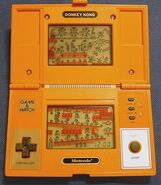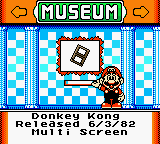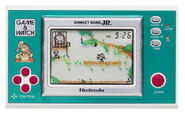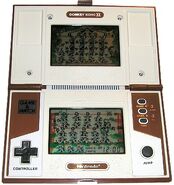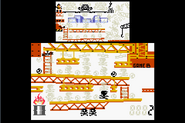This page explains in detail the interactions between the Donkey Kong series and the Game & Watch Gallery series.
Game & Watch Gallery[]
February 1, 1997
Donkey Kong![]() Game & Watch Gallery
Game & Watch Gallery
In Game & Watch Gallery (known in Japan as Game Boy Gallery 2), while there isn't any Donkey Kong-specific game, Donkey Kong Jr. is featured as a generic non-player character in all playable games except Octopus, since it doesn't feature any generic person in the game. Oddly, due to the games' gameplay, more than one Donkey Kong Jr. can show up at the same time in Manhole and Fire. For details see:
Game & Watch Gallery 2[]
September 27, 1997
Donkey Kong![]() Game & Watch Gallery
Game & Watch Gallery
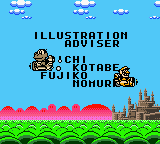
Donkey Kong Jr. with Wario in the Staff credits.
This time the game features an original playable Donkey Kong game: Donkey Kong, plus two Gallery games.
Additionally, like in most games in the previous title, Donkey Kong Jr. once again takes the role of the generic character, but the only game to feature generic characters is Parachute (see Donkey Kong X Parachute for details). However this time the game also features end credits showing characters from the Modern versions of the games, including Donkey Kong Jr., who's flying on a plane. Since this scene takes place outside any Game & Watch game, it's supposed to take place in the universe of Game & Watch Gallery 2 itself (where the original fictional places such as the music room and the museum are set), making this an In-universe link.
Oddly, Donkey Kong Jr. also appears in the select screen when Donkey Kong is selected, despite him not being in the game itself.
Donkey Kong[]
The Game & Watch game Donkey Kong is featured as one of the main playable games, available in both "Classic" and "Modern" versions, as well as in the game's Museum:
"Classic" Version[]
The "Classic" version of Donkey Kong uses the same gameplay and recreates the graphics of the original game, but since it was a Multi-Screen game, both screens are here squeezed into the Game Boy screen, and like for Oil Panic in the previous game, one of the two screen is zoomed in, and the other is zoomed out, but this time the player is able to switch between the two by pressing the B button. Like all other games, the Super Game Boy border recreates the design of the original game, still adapted to the single screen.
"Modern" Version[]

The "Modern " version of Donkey Kong features improved graphics with many elements from the Mario series, most notably Pauline being replaced by Peach and the addition of Koopa Troopas (see here for details on these elements). Also the background changes each time Donkey Kong is defeated and there are three different stages, but without any specific difference in gameplay for the most part. Instead of having two separate screens, the screen will now scroll up after Mario reaches the second floor. The basic gameplay is the same as the original game, but there are some significant differences:
- Mario always starts already in the first position of the first floor, while in the original game the player had to press the jump button to make him move from the life count to the first position.
- There isn't any grider to prevent Mario from jumping, so in both bottom floors he's free to jump in any position, except when in front of the ladder leading to the third floor, like in the original game, and at the starting position, unlike the original game, because he starts on top of a Warp Pipe. The starting point is a safe spot, but he'll automatically step ahead after about 6 seconds.
- The first ladder, connecting the first floor to the second floor, has been replaced with a Warp Pipe, so the player has to press the jump button to make Mario reach the second floor, instead of pressing the up button. Also barrels roll through it, instead of over it, meaning that they directly fall on Mario, however by entering the Warp Pipe at the same time as the barrel makes Mario avoid it, even if this requires better timing than the original game.
- Based on the Donkey Kong Jr. Game & Watch, there now are chains or other things for Mario to hold on to after jumping, and staying safe, however they'll fall after about 6 seconds and then reappear after 2 seconds. There is a chain, vine or rope in the second and fourth positions on the first floor, while he can grab the falling platforms above from the second, third and fourth positions on the second floor. After Mario falls or climbs down, every obstacle that passed below him will count as jumped over, and the respective amount of points will be added.
- After a barrel reaches the end of the trail, it will break and a Koopa Troopa will come out of it, based on the original arcade Donkey Kong, where Fireballs would come out of the Oil Can when it's hit by a barrel. The Koopa Troopas walk in the opposite direction to the barrels, to the end of the first floor and then disappear offscreen. They can be stomped by Mario and doing so is worth 5 points. Jumping over them is worth one point, like the barrels.
- If Mario is on the upper floors, barrels disappear once they reach the first floor, because of it being offscreen.
- The moving griders on the second floor are replaced by Koopa Paratroopas. They may come from both sides of the screen and they fly straight in Easy Mode, while they They fly in a bouncing pattern in Hard and Very Hard modes, meaning that they stay above Mario, preventing him from jumping only on the first, third and fifth positions, while on the second and fourth positions they stand on the ground, preventing him from walking ahead. They can be stomped on by moving to a position without a platform on the third floor, jumping from the first position of the second floor, or, in Hard and Very Hard Mode, by climbing down of a falling platform while the Paratroopa is standing below. Stomping a flying Paratroopa is worth 5 points, while stomping a standing one is only worth 1 point, but either way it turns into a Koopa Troopa. If the Paratroopa is flying over the first position of the second floor, it falls offscreen if stomped on, otherwise the Koopa Troopa starts walking back and forth in the three middle positions of the second floor. Stomping a Koopa Troopa on the second floor is worth 3 points, but no points are awarded for jumping over a Koopa Troopa or Paratroopa on the second floor.
- There no more is the floor between the second and the third, only used by barrels in the original game, meaning that there's no more Mario's single position on that floor. Also, barrels disappear if Donkey Kong throws them to any position on the third floor other than the first position (the switch position), disappearing otherwhise. In fact he always throws barrels to that position unless Mario is on the third floor.
- If Mario is on the third floor, Donkey Kong systematically throws barrels at his position, rather than at random positions.
- The second, third and fourth positions on the third floor are now falling platforms, meaning that if Mario stands on the same position for about 3 seconds, the platform falls down. If Mario stands on a position with no platform, he falls to the corresponding position on the second floor.
- Instead of activating a crane, turning on the switch makes a moving platform or disappearing clouds appear, having a different movement pattern in each stage. Also, after jumping on it Mario will also have to jump to the door on Donkey Kong's floor, making his platform shrink.
- Missing the moving platform doesn't count as a miss, unlike the crane in the original game, but simply makes Mario fall to the first position of the second floor.
- Defeating Donkey Kong is only worth 15 points, rather than 20 points.
- Every time Mario is defeated all obstacles disappear.
- Instead of gaining an extra life at 300 points, a 1-Up Heart appears in the first position of the second floor at 200, 300 and 500 points, adding a life if it's picked. Nothing happens if the player still has both extra lives, while in the original game a third extra life could be granted and points were doubled until getting a miss.
Gallery games[]
The Museum is unlocked after obtaining 10 stars at games, and Donkey Kong is automatically available in it. The New Wide Screen Donkey Kong Jr. is unlocked after obtaining 50 stars at games.
Game & Watch Gallery 3[]
August 04, 1999
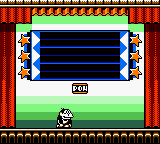
Donkey Kong Jr. in the game's credits.
Donkey Kong![]() Game & Watch Gallery
Game & Watch Gallery
This episode features two playable Donkey Kong games: Donkey Kong Jr. and Donkey Kong II, plus three new Gallery games.
Additionally, like in the previous title, Donkey Kong Jr. makes an appearance in the game's credits, that take place on a stage, and he's seen hitting a POW block from Mario Bros. to make part of the credits appear. This time there's no game with generic characters, so Donkey Kong Jr. doesn't make any appearance in games outside his own two.
Donkey Kong Jr.[]
The New Wide Screen Game & Watch game Donkey Kong Jr. is featured as one of the main playable games, available in both "Classic" and "Modern" versions:
"Classic" version[]
A loyal reproduction of the original game, it appears sliglthy squeezed, due to the Game Boy screen being less wide than the original game. The color scheme is the same as the original only if it's played on a Game Boy Color, otherwise it results darker. If the game is played on a Super Game Boy, however, the border recreates the design of the border of the screen of the original game.
"Modern" version[]
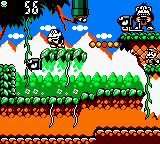
"Modern" Donkey Kong Jr.
The "Modern" version of Donkey Kong Jr. features improved graphics with many elements from the Mario series (see here for details on these elements). There are three different stages, rotating, each one accessed after freeing Donkey Kong in the previous stage. Each stage instead of featuring a swinging key that must be catched at the right time, it features a still key that once picked makes a "bridge" appear that must be crossed at the right time. The fist stage is based on the original game, but due to the new gameplay elements, there's an additional third floor connecting the key to the cage. The second stage takes place over a pit with many vines hangin down, similarly to Stage 1 of the arcade Donkey Kong Jr. and the Panorama Screen Donkey Kong Jr. Game & Watch. The third stage is very similar to the first one, but the first level has no floor, forcing Donkey Kong Junior to move on vines. The basic gameplay is the same as the original game, but with some differences. In detail:
- Donkey Kong Jr. can now jump by pressing up.
- Snapjaws are replaced by Goombas, and like in Mario games they can be stomped, which is worth 1 point, the same as jumping over them. Goombas are replaced with Spinies, that can't be stomped on, in Very Hard Mode and after all three levels are beaten four times in Easy Mode, and two times in Hard Mode.
- Nitpickers are replaced by Bullet Bills, that can be stomped, which is worth 1 point.
- The second and third stages also feature Nipper Plant enemies from the Mario series, that jump around and then climb down vines, like Snapjaws in the original arcade Donkey Kong Jr. They can't be stomped, and jumping over them doesn't award any point.
- Hitting an enemy with a falling fruit is always worth 5 points, while in the original game it was worth 3 for Snapjaws at the second floor, 6 for Nitpickers and 9 for Snapjaws at the bottom floor.
- Like in the original arcade Donkey Kong Jr., fruits automatically reappear after a while in the second stage.
- Like in the original game, Donkey Kong Jr. can hang on small vines only for a small amount of time, but here the vines also disappear for a short time, meaning he can't jump back up until they reappear. Also, unlike the original game, there's no difference in the time he can stay on the vine between Easy and Hard Mode.
- Donkey Kong Jr. doesn't fall from long vines connecting floors, while in the original game he would fall from the bottom part of the vine connecting the two floors. He wouldn't fall from the upper part, though.
- Unlike missing the key in the original game, missing the bridge to the cage doesn't count as a miss, but makes Donkey Kong Jr. simply fall to the platform below. Also, to jump on the bridge and then to the cage the player only has to press the direction button, rather than the direction together with the jump button.
- Every time Donkey Kong Jr. returns to the starting position after being defeated or after bringing the key to the cage, all enemies disappear, while in the original game only the enemies near the starting position would disappear.
- Freeing Donkey Kong is only worth 10 points (plus the points for opening the fourth quarter of the cage), rather than 20 points.
- Instead of gaining an extra life at 300 points, a 1-Up Heart appears in the rightmost position of the first floor in Stages 1 and 3, or below the "bridge" in Stage 2, at 200, 300 and 500 points, removing a miss if it's picked. Nothing happens if the player doesn't have any miss, while in the original game points were doubled until getting a miss.
Donkey Kong II[]
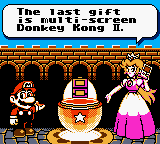
Donkey Kong II being unlocked.
Donkey Kong II is featured as one of the secondary unlockable games, only playable in "Classic" mode. Unlocked after obtaining 50 stars at games, its gameplay and graphics recreate the original game, and like all other vertical Multi Screen games, one of the two screens is zoomed in, and the other is zoomed out, switching between the two by pressing the B button. As always, if the game is played on a Super Game Boy, the border recreates the design of the original game, adapted for the single screen.
Additionally, while describing the game after unlocking it, Peach can be seen holding a Donkey Kong Jr. plush doll.
Gallery games[]
This game's Gallery Corner features three Donkey Kong games in the Museum:
- Donkey Kong II, unlocked after obtaining 15 Stars at games.
- Donkey Kong Hockey, unlocked after obtaining 35 Stars at games.
- Donkey Kong Circus, unlocked after obtaining 45 Stars at games.
Additionally, by connecting the game with Game & Watch Gallery 2, every Gallery game unlocked in that game will also be available in Game & Watch Gallery 3, including Donkey Kong and Donkey Kong Jr. These can all be alternatively unlocked by obtaining 120 Stars at games.
Game & Watch Gallery Advance[]
October 25, 2002
Donkey Kong![]() Game & Watch Gallery
Game & Watch Gallery
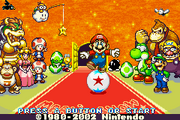
Introduction of the game, before the title screen appears. Donkey Kong is on the far right, Donkey Kong Jr. on the bottom left, and the Nitpicker is on the upper left.
The last game in the Game & Watch Gallery series features three Donkey Kong games: Donkey Kong Jr. (New Wide Screen), already featured in Game & Watch Gallery 3, the new Donkey Kong 3, and the unlockable Donkey Kong, already featured in Game & Watch Gallery 2.
This time the title screen not only shows Mario, but many other characters as well, including Donkey Kong, Donkey Kong Jr. and a Nitpicker, creating an In-universe link.
Donkey Kong Jr.[]
The New Wide Screen Donkey Kong Jr. is one of the six starting games, available in both "Classic" and "Modern" versions, and returns from Game & Watch Gallery 3.
"Classic" version[]
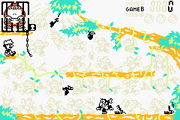
"Classic" Donkey Kong Jr. features the same gameplay and reproduces the graphics of the original game, also thanks to the sizes of the Game Boy Advance screen being almost exactly the same of a New Wide Screen Game & Watch.
"Modern" version[]
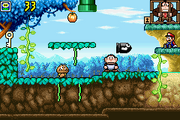
The "Modern" version of Donkey Kong Jr. is the same as the one featured in Game & Watch Gallery 3 and retains the Mario elements (see here for details), but features improved graphics. The only gameplay difference is Spinies no longer appearing at a certain point in Easy and Hard mode, but replacing Goombas only in Very Hard mode.
Donkey Kong 3[]
Donkey Kong 3 is one of the six starting games, and it's new to the Game & Watch Gallery series. It's one of the two games in this release to feature multiplayer gameplay as "Game B" instead of increased difficulty (the other being Boxing), following Judge in Game & Watch Gallery 3. The Game Link Cable and two Game Boy Advances each with a copy of the game are required to play multiplayer games. Each time a multiplayer game is played, a star is earned regardless of the winner.
"Classic" version[]
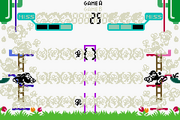
"Classic" Donkey Kong 3 reproduces the same gameplay and graphics as the original game, but the screen appears slightly squeezed due to the original screen being wider than the Game Boy Advance screen.
"Modern" version[]
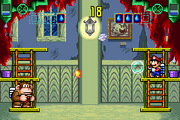
"Modern" Donkey Kong 3 features improved graphics with Mario replacing Stanley and some other elements from the Mario series (see here for details). The gameplay is the same as the original game, only with some changes:
- Each character has four shots in their tank, rather than three.
- The bubbles shot by the characters, replacing the spray puffs, break against each other, instead of passing through.
- The Boo, replacing one of the flies, moves up and down more slowly, but also moves toward the nearest character while he's not looking at it. Obviously the Boo doesn't move when it's in the middle of the stage.
- The two enemies still block each other when are vertically alligned or when one of them is shot toward the other, however shooting one of them while the other is moving to the same position (either because moving vertically, or because being shot at the same time) can make them end overlapping. Shooting the overlapping enemies will only move the Boo though.
Donkey Kong[]

Donkey Kong being unlocked.
Donkey Kong is the third game to be unlocked in the game and becomes available after obtaining 35 stars at games. It returns from Game & Watch Gallery 2.
"Classic" version[]
The "Classic" version of Donkey Kong is a recolored version of the one featured in Game & Watch Gallery 2, using the exact same sprites, only with a grey shadow of the unactive sprites being added. The gameplay is the same, also with the zoom being switched between the two screens by pressing the B button.
"Modern" version[]
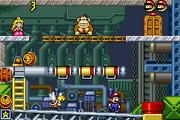
"Modern" Donkey Kong.
The "Modern" version of Donkey Kong is the same as the one featured in Game & Watch Gallery 2, only with improved graphics and some minor changes, but it retains the Mario elements (see here for details), and the same exact gameplay.
"Modern" versions of other games[]
Like in previous games, Donkey Kong Jr. once again has the role of a generic person in "Modern" versions of other games, however the only games to feature them are Fire, previously featured in Game & Watch Gallery, and Rain Shower, where they replace the hanged clothes. For details see:
License[]
Copyrights for both series are held by Nintendo.


